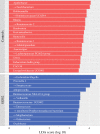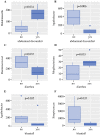Distal Gastrectomy with Billroth II Reconstruction is Associated with Oralization of Gut Microbiome and Intestinal Inflammation: A Proof-of-Concept Study
- PMID: 32504369
- PMCID: PMC7801296
- DOI: 10.1245/s10434-020-08678-1
Distal Gastrectomy with Billroth II Reconstruction is Associated with Oralization of Gut Microbiome and Intestinal Inflammation: A Proof-of-Concept Study
Abstract
Background: Subtotal gastrectomy with Billroth II reconstruction (SGB2) results in increased gastric pH and diminished gastric barrier. Increased gastric pH following PPI therapy has an impact on the gut microbiome, intestinal inflammation, and possibly patient health. If similar changes are present after SGB2, these can be relevant for patient health and long-term outcomes after surgery. The aim of the study is to investigate whether SGB2 is associated with specific changes in gut microbiome composition and intestinal inflammation.
Patients and methods: This cross-sectional proof-of-concept study includes patients after SGB2 (n = 14) for early gastric cancer and their nongastrectomized in-house relatives as controls (n = 8). Fecal microbiome composition, intestinal inflammation (fecal calprotectin), gut permeability (DAO, LBP, sCD14), systemic inflammation (CRP) markers, and gastrointestinal symptoms are investigated. This study is registered at ClinicalTrials.gov (NCT03418428).
Results: Microbiome oralization following SGB2 was defined by an increase in Escherichia-Shigella, Enterococcus, Streptococcus, and other typical oral cavity bacteria (Veillonella, Oribacterium, and Mogibacterium) abundance. The fecal calprotectin was increased in the SGB2 group [100.9 (52.1; 292) vs. 25.8 (17; 66.5); p = 0.014], and calprotectin levels positively correlated with the abundance of Streptococcus (rs = 0.639; padj = 0.023). Gastrointestinal symptoms in SGB2 patients were associated with distinct taxonomic changes of the gut microbiome.
Conclusions: SGB2 is associated with oralization of the gut microbiome; intestinal inflammation and microbiome changes were associated with gastrointestinal symptoms. These novel findings may open gut microbiome as a new target for therapy to improve quality of life and general patient health in long-term survivors after SGB2.
Conflict of interest statement
The authors declare no conflict of interest.
Figures





Similar articles
-
Gut Microbiome Changes After Neoadjuvant Chemotherapy and Surgery in Patients with Gastric Cancer.Cancers (Basel). 2024 Dec 5;16(23):4074. doi: 10.3390/cancers16234074. Cancers (Basel). 2024. PMID: 39682264 Free PMC article.
-
ASO Author Reflections: Gut Microbiome Oralization and Intestinal Inflammation After Distal Gastrectomy with Billroth II Reconstruction is Linked to Gastrointestinal Symptoms.Ann Surg Oncol. 2020 Dec;27(Suppl 3):775-776. doi: 10.1245/s10434-020-08703-3. Epub 2020 Jun 8. Ann Surg Oncol. 2020. PMID: 32514808 Free PMC article. No abstract available.
-
Biomarkers for oralization during long-term proton pump inhibitor therapy predict survival in cirrhosis.Sci Rep. 2019 Aug 19;9(1):12000. doi: 10.1038/s41598-019-48352-5. Sci Rep. 2019. PMID: 31427714 Free PMC article.
-
Gastrectomy impact on the gut microbiome in patients with gastric cancer: A comprehensive review.World J Gastrointest Surg. 2021 Jul 27;13(7):678-688. doi: 10.4240/wjgs.v13.i7.678. World J Gastrointest Surg. 2021. PMID: 34354801 Free PMC article. Review.
-
[Comparison of different reconstruction procedures after distal gastrectomy in patients with gastric cancer].Zhonghua Yi Xue Za Zhi. 2020 Dec 29;100(48):3884-3889. doi: 10.3760/cma.j.cn112137-20200422-01279. Zhonghua Yi Xue Za Zhi. 2020. PMID: 33371636 Chinese.
Cited by
-
Incidence and clinical relevance of postoperative diarrhea after minimally invasive gastrectomy for gastric cancer: a single institution retrospective study of 1476 patients.Langenbecks Arch Surg. 2023 Sep 19;408(1):364. doi: 10.1007/s00423-023-03097-8. Langenbecks Arch Surg. 2023. PMID: 37725176
-
The Implication of Gastric Microbiome in the Treatment of Gastric Cancer.Cancers (Basel). 2022 Apr 18;14(8):2039. doi: 10.3390/cancers14082039. Cancers (Basel). 2022. PMID: 35454944 Free PMC article. Review.
-
Time-course alterations of gut microbiota and short-chain fatty acids after short-term lincomycin exposure in young swine.Appl Microbiol Biotechnol. 2021 Nov;105(21-22):8441-8456. doi: 10.1007/s00253-021-11627-x. Epub 2021 Oct 15. Appl Microbiol Biotechnol. 2021. PMID: 34651253
-
Tributyrin and anise mixture supplementation improves growth performance, nutrient digestibility, jejunal villus height, and fecal microbiota in weaned pigs.Front Vet Sci. 2023 Jan 27;10:1107149. doi: 10.3389/fvets.2023.1107149. eCollection 2023. Front Vet Sci. 2023. PMID: 36777676 Free PMC article.
-
Ultra-early weaning alters growth performance, hematology parameters, and fecal microbiota in piglets with same genetic background.Front Microbiol. 2022 Nov 2;13:990905. doi: 10.3389/fmicb.2022.990905. eCollection 2022. Front Microbiol. 2022. PMID: 36406459 Free PMC article.
References
-
- Tran TB, Worhunsky DJ, Squires MH, Jin LX, Spolverato G, Votanopoulos KI, et al. To Roux or not to Roux: a comparison between Roux-en-Y and Billroth II reconstruction following partial gastrectomy for gastric cancer. Gastric Cancer. 2016;19(3):994–1001. doi: 10.1007/s10120-015-0547-3. - DOI - PubMed
MeSH terms
Substances
Associated data
LinkOut - more resources
Full Text Sources
Medical
Molecular Biology Databases
Research Materials
Miscellaneous

